The Fariña Files | home
Time Line | Cast of characters | Cast of Characters 2 | Cast of Characters 3 | This One's For Mimi | The Books - a guide | Newport Folk Festival 1965 | Dick and Mimi - where they were, how they got there, and what they did for three days | Newport Folk Festival - July 22, 23rd | Newport Folk Festival - Saturday, July 24th | Newport Folk Festival - Sunday, July 25th | Photos and Sources | Annotated Discography | Four for Fun | Web site bibliography | Favorite Links | Contact Me
Newport Folk Festival - Sunday, July 25th
(note: this performance, edited down to three songs, is available on Memories, both the LP ( VSD- 79263), and CD (79263-2)
|
"It's raining! It's raining! Have mercy!"
Sunday morning started out overcast. But if you looked at the history of the coastal Newport, Rhode Island, it's likely the percentages would lean in that direction for the better part of the year. So one more day didn't mean much to anyone. The weather predicted the possibility of showers, but with the way the weekend was running so far, the weather could have predicted Ooblik and nobody would have cared as long as the music went on as scheduled and the beer tent was still open.
On the schedule were only three events, and all slated for the main stage; the 10:00 a.m. Concert of Religious Music -- where hell was kept at bay; Peter Yarrow's (oddly scheduled) 2:20 afternoon concert, New
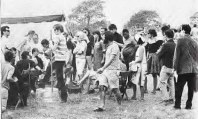 Folks , which went from heaven to hell and back again; and the finale, the Evening Concert (whose theme, as announced by Pete Seeger, was to be a message from the performers to a newborn child about the state of the world ) , where Dylan plugged in and some people's vision of hell was made manifest, while others floated on angels' wings. Folks , which went from heaven to hell and back again; and the finale, the Evening Concert (whose theme, as announced by Pete Seeger, was to be a message from the performers to a newborn child about the state of the world ) , where Dylan plugged in and some people's vision of hell was made manifest, while others floated on angels' wings. Dick's plans for the afternoon included bringing several other performers up on stage to fill out their sound , capitalize on and enhance the image they'd made with their Saturday workshops and create a memorable party atmosphere on stage that no one would forget. To that end, most likely either during the sparsely attended Religious Concert ( because Dylan borrowed the Main Stage between the end of the Religious Concert and the beginnings of New Folks to run his ad-hoc electric band
 through their three songs and do a sound check, and it would have been impossible to hear anything anywhere near the stage), or during the first ten acts of the New Folks, Dick and Mimi practiced several songs outside the performers' area with Al Kooper, Fritz Richmond, and Kyle Garahan, observed by Butterfield, Rev. Gary Davis (who, though scheduled for the Religious Concert, obviously wasn't performing there at the time), a nattily attired Eric Von Schmidt (surfer shirt, burmudas and sandals) and about 25 others. From the photos of both the Religious Concert (where the sun came out briefly to see its favorite, Son House) and the practice, though hot and dusty, it's clear the sky was beginning to cloud over... through their three songs and do a sound check, and it would have been impossible to hear anything anywhere near the stage), or during the first ten acts of the New Folks, Dick and Mimi practiced several songs outside the performers' area with Al Kooper, Fritz Richmond, and Kyle Garahan, observed by Butterfield, Rev. Gary Davis (who, though scheduled for the Religious Concert, obviously wasn't performing there at the time), a nattily attired Eric Von Schmidt (surfer shirt, burmudas and sandals) and about 25 others. From the photos of both the Religious Concert (where the sun came out briefly to see its favorite, Son House) and the practice, though hot and dusty, it's clear the sky was beginning to cloud over... New Folks, though due to start at 2:20, actually started about 2:30 under the three-story high canopy of the Main Stage , as the skies continued to cloud up. The concert being about three hours, everyone would ideally get 15 minutes, though, again, this didn't always hold true. As Robert Jones explains : "Somebody might have sung 30 minutes, then somebody sang two tunes, then another person sang two tunes.... It was not formatted, it just sort of fell in like that. And because of the technical situation, which basically was one or two microphones, maybe two at the most, maybe three at some places, one was limited -- you couldn't have three people playing together, because two people probably would not have a chance to be heard (where only one mike was available). And the recording was [done inside] just a small little van behind them, recording them". Those limitations understood, first up was Byron & Lue Berline, a father and son fiddling duo from Oklahoma , accompanied by two of Boston's finest, Jim Rooney on guitar and Bill Keith on banjo. Spider John Koerner followed, accompanied by fellow Minnesotan, Tony Glover; followed in order by the Blue Ridge Mountain Dancers, Hamilton Camp, Kathy & Carol (performing an acapella version of the Fariña-composed , A Swallow Song, and had probably, as a courtesy, checked with Dick to make sure they weren't doing it too), Mark Spoelstra, the Chambers Brothers ( a wonderful gospel group transforming themselves into a formidable rock band, now dressed-down from their morning appearance at the Religious Concert) - joined by Joan Baez and Sam Lay on drums from the Butterfield Band), singer-songwriter Patrick Sky, followed by another stage-stomping appearance by the dancers, and then Gordon Lightfoot capping off his debut weekend. The Charles River Valley Boys, also in the program as slotted here, opted instead to perform that morning at the Religious Concert. With the skies thickening and growing darker and the chances for rain increasing the odds with every flutter of the breeze, Dick and Mimi Fariña took stage somewhere about 4:45.
With Dick wearing what looks like pressed brown corduroy Levis, Beatle boots and his short-sleeved black turtle neck and Mimi in a sleeveless, striped jumper with, as always, no shoes, they sat on the folding chairs, adjusted their two microphones (each!), and let the party begin slowly, with the intention of gathering speed with each song. The audience was about to get a quick glimpse of the size of Dick Fariña's Kicks Warehouse.
|
Never having heard the existing tapes, I have constructed this thin raft to float a theory which is mine (in whole or in part) on that day's playlist. After sifting through Hajdu's Positively 4th Street , the existing released tapes, 35 years of hearsay, and a host of way-too-close examinations of their segment in the film Festival , I've found this to be the sequence that works best -
1. "Birmingham Sunday", This again was Dick's solemn song about the deaths by bombing of three young African-American girls in the basement of an Alabama church, and has been noted by Hajdu as a probable - and by others as a definite - opener.
2. "The Falcon" - (And here I veer off from Hajdu) They must have done another slow one, where Dick's master plan was carried out with step 1: Gradually start bringing on other performers. This one being Joan Baez, which would certainly have been a plotted idea to get things moving by inviting the reigning Queen Of Folk, as well as Mimi's sister and Dick's sister-in-
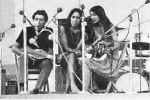 law, out to grab the audience's attention. (Backed up by an interview I had with Eric Von Schmidt thirty years ago, in which I remember him saying he was furious at Baez because she came back out later on, which he saw as an attempt to steal some of Dick and Mimi's hard-earned glory). The photos show Dick and Mimi singing, eyes closed, with Joan joining them in the middle. According to Hajdu, Joan wasn't on stage until the end, when they performed another rousing sing-along version of "Pack Up Your Sorrows", surrounded by three additional players (who'd have to crowd the two vocal mikes) and people swirling all around law, out to grab the audience's attention. (Backed up by an interview I had with Eric Von Schmidt thirty years ago, in which I remember him saying he was furious at Baez because she came back out later on, which he saw as an attempt to steal some of Dick and Mimi's hard-earned glory). The photos show Dick and Mimi singing, eyes closed, with Joan joining them in the middle. According to Hajdu, Joan wasn't on stage until the end, when they performed another rousing sing-along version of "Pack Up Your Sorrows", surrounded by three additional players (who'd have to crowd the two vocal mikes) and people swirling all around 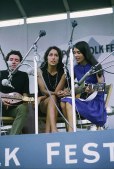 them. In the Gahr photo, there is Mimi on stage left, Joan in the middle, Dick on stage right. And no one else -- two mikes for the voices, two mikes for the instruments. Dick holds his dulcimer sideways with his arm across it, holding it on the bottom, which, considering the finale song has a constant dulcimer part, is not the optimum way to coax a tune from a stringed instrument. Meanwhile Mimi carefully picks strings and Joan crosses her arms and looks downright gloomy. Or soulful. None of the three are exactly bouncing in their seats, or showing the usual outward signs of ecstatic success. What Hajdu writes about "Birmingham Sunday" fits much better here - "The ballad was apparently not moving the festival crowd as it had in Mimi and Richard's club shows; people were squirming in their seats . Before the song was over, at least a dozen of them got up and left. Mimi was horrified; Richard stiffened, but he grinned and adhered to his plan, introducing Fritz Richmond." In the Waterman photo in Von Schmidt & Rooney's Baby Let Me Follow You them. In the Gahr photo, there is Mimi on stage left, Joan in the middle, Dick on stage right. And no one else -- two mikes for the voices, two mikes for the instruments. Dick holds his dulcimer sideways with his arm across it, holding it on the bottom, which, considering the finale song has a constant dulcimer part, is not the optimum way to coax a tune from a stringed instrument. Meanwhile Mimi carefully picks strings and Joan crosses her arms and looks downright gloomy. Or soulful. None of the three are exactly bouncing in their seats, or showing the usual outward signs of ecstatic success. What Hajdu writes about "Birmingham Sunday" fits much better here - "The ballad was apparently not moving the festival crowd as it had in Mimi and Richard's club shows; people were squirming in their seats . Before the song was over, at least a dozen of them got up and left. Mimi was horrified; Richard stiffened, but he grinned and adhered to his plan, introducing Fritz Richmond." In the Waterman photo in Von Schmidt & Rooney's Baby Let Me Follow You 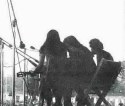 Down, we see over the shoulders of the three, into the audience. At this point, the sky is very gray, top to bottom, but the crowd seem, for the most part, to be in their seats with their faces towards the stage, not investigating low-flying clouds and dripping water. Down, we see over the shoulders of the three, into the audience. At this point, the sky is very gray, top to bottom, but the crowd seem, for the most part, to be in their seats with their faces towards the stage, not investigating low-flying clouds and dripping water. ** "Hard-Lovin' Loser" - I have my doubts that this was done, though Hajdu's interview with Mimi says it was, and I've also heard so over the years : "We went from that [the first song] straight into Hard Lovin' Loser and everything else we did that cooked," said Mimi. "I looked out, and the audience started dancing in the pouring rain. Everybody was getting soaked, and people were laughing and dancing to the music." Here, I suspect Mimi may have been telescoping things only half remembered (Mimi wrote me a short note at one point on the subject of Newport, "...in 30 years' time I have forgotten a great deal.") But then, Hajdu had access to the tapes....
3. "
4. "House Un-American Blues Activity Dream" - You can tell on the recording that Dick's in a hurry because he drops his beloved lengthy intro to the song and let's her rip. It was clearly time to get moving, and the Fariñas were as ready as the day is long. But somewhere during this song (I suspect it's near the end of the first verse, right on the word "pill" in the line "So I hopped on a plane, I took a pill for my brain," because both Dick AND Mimi hesitate on cue at a common distraction, Mimi giggles very slightly, and in a millisecond
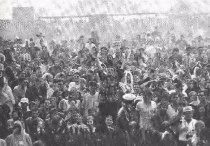 both go back into the song), the clouds dumped what they had. With very little chance to duck for cover, most of the crowd was instantly soaked ("Really, where else could they go? The beer tent was the nearest place, and it was a little late..." said Waterman) and stayed in place. Rain pounded the crowd. In both go back into the song), the clouds dumped what they had. With very little chance to duck for cover, most of the crowd was instantly soaked ("Really, where else could they go? The beer tent was the nearest place, and it was a little late..." said Waterman) and stayed in place. Rain pounded the crowd. In 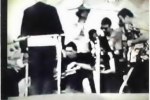 the film, a stage hand comes out during the song, stands in front of Dick and tries to protect the mike, if not move it back as much as can be without physically lifting the performers and their chairs. Joan is still dancing, but has moved stage right behind Mimi, who now has two Board of Directors members hovering over her -- Ralph Rinzler has dashed over with a large striped umbrella and holds it over as much of Dick and Mimi as he can manage; Peter Yarrow has come over to tell Mimi about the dangers to be found in introducing water to electricity (Hajdu : " Peter Yarrow bolted out to tell Mimi and Richard to stop -- the audience wanted to leave, and the rain was unsafe for everyone near the stage; the microphones and wiring were not weatherproof and needed to be shut off immediately"). At the the film, a stage hand comes out during the song, stands in front of Dick and tries to protect the mike, if not move it back as much as can be without physically lifting the performers and their chairs. Joan is still dancing, but has moved stage right behind Mimi, who now has two Board of Directors members hovering over her -- Ralph Rinzler has dashed over with a large striped umbrella and holds it over as much of Dick and Mimi as he can manage; Peter Yarrow has come over to tell Mimi about the dangers to be found in introducing water to electricity (Hajdu : " Peter Yarrow bolted out to tell Mimi and Richard to stop -- the audience wanted to leave, and the rain was unsafe for everyone near the stage; the microphones and wiring were not weatherproof and needed to be shut off immediately"). At the  end of the song there is thunderous applause, though some still obviously unsure if the Fariñas will continue or if the show will be shut down. Dick quickly says, "Ladies and gentlemen! Wait, wait, wait, waitwait! Wait!", and I believe it was clear to Yarrow and everyone else that the crowd wasn't going anywhere except closer and the Fariñas were staying. Quickly adapting to the change, and probably just as eager as Dick and Mimi for them to succeed and his New Folks concert not to be washed out, Yarrow grabs a mike and announces, "Right, come on back, come on back," then off-mike to the stagehands, " Move this whole thing back -- all the mikes and everything -- everything comes back," then refocuses on the crowd, adding, "all right. While we get the mikes set up, out of the rain so they won't be clobbered ("Bothered?" questions a comically incredulous Richmond), I wanna make one point very clear -- it is not raining!" to wild cheers and applause, probably from both sides of the proscenium. Everything is brought back, including the Fariñas. Slightly revising Hajdu's chronology again (though he's heard the tapes), I'd say it is at this point that Dick tells the crowd, "Okay everybody. Everybody get up from your seats now, okay? You can't dance sitting down! Right? Okay - let's go! Let's boogie!". And as I've heard from all directions, the Fariñas proceed to pull out every fast song they know. The audience commenced a soggy boogie in open defiance of Artie Shaw's minimalist claim that "If you wanna dance, a windshield wiper'll do it - all you need is a beat." end of the song there is thunderous applause, though some still obviously unsure if the Fariñas will continue or if the show will be shut down. Dick quickly says, "Ladies and gentlemen! Wait, wait, wait, waitwait! Wait!", and I believe it was clear to Yarrow and everyone else that the crowd wasn't going anywhere except closer and the Fariñas were staying. Quickly adapting to the change, and probably just as eager as Dick and Mimi for them to succeed and his New Folks concert not to be washed out, Yarrow grabs a mike and announces, "Right, come on back, come on back," then off-mike to the stagehands, " Move this whole thing back -- all the mikes and everything -- everything comes back," then refocuses on the crowd, adding, "all right. While we get the mikes set up, out of the rain so they won't be clobbered ("Bothered?" questions a comically incredulous Richmond), I wanna make one point very clear -- it is not raining!" to wild cheers and applause, probably from both sides of the proscenium. Everything is brought back, including the Fariñas. Slightly revising Hajdu's chronology again (though he's heard the tapes), I'd say it is at this point that Dick tells the crowd, "Okay everybody. Everybody get up from your seats now, okay? You can't dance sitting down! Right? Okay - let's go! Let's boogie!". And as I've heard from all directions, the Fariñas proceed to pull out every fast song they know. The audience commenced a soggy boogie in open defiance of Artie Shaw's minimalist claim that "If you wanna dance, a windshield wiper'll do it - all you need is a beat." 5. "One Way Ticket" - This song is unknown among those who've tried to piece together a set list over the years, but can be detected by the active anal-retentive mind as it zips past on five seconds worth of audio tape in the Festival film, playing against what is probably the Dopico/Celebrations footage. (It should be noted here the Fariña footage in that film is seemingly all done against non-synchronized soundtrack. The soundtrack is a collage of the Fariñas' performances that day put together by director Murray Lerner and his editor, Howard Alk. Starting with thunder, the performances start with "One Way Ticket" separated after five seconds by another thunderclap before splicing right into "Reno Nevada", then the Yarrow "not raining" quote, followed by "Pack Up Your Sorrows". The film footage, however, is something else again. It appears to be thus; "House Un-American" runs under "One Way Ticket." It may or may not be slightly skewed sound against its actual background of "Reno, Nevada" -- the clapping and dancing is usually to the correct beat - then back to "House Un-American", as witnessed by Kyle Garahan leaning into Dick's microphone, then a pan of the audience followed by footage of the end of "Reno" and into "Pack Up Your Sorrows.")
6. "Reno Nevada" - The film footage shows a by now drenched Joan Baez (hence the dating late in the chronology) dancing next to a loopy and slightly soggy Peter Yarrow, who bops past a very dry Noel Stookey while the soundtrack plays an almost to-the-beat background of "Reno Nevada", though the cuts back and forth are a bit confusing.
The possibility that the songs played and those filmed could be widely different, with the whole performance filmed and selected footage used here and there from all the songs is a possibility largely scoffed at by a filmmaker/collector and fan I know who went directly to the Murray Lerner and asked about outtakes. He was told that due to budgetary concerns, literally, everything they filmed was in the movie - hence, they only filmed half of Howlin' Wolf's set (seen right before the Fariñas, though actually from a year later), which was who the fan/film collector was mainly curious about. And they only filmed, or had usable footage on (though possibly the audio was good -- hence the collage), parts of the festivals, here and there. Unlike Vanguard who taped everything, no one else was ever sure of what was taped. There was always some confusion about this -- a letter exists in the Archive of Folk Culture in the American Folklife Center of the Library of Congress from Geoff Muldaur asking if they have any festival tapes, if they know what tapes exist or even where they are. Nobody was ever quite sure. It now appears, per Mary Katherine Aldin's remarkable reissue program at that label, that Vanguard taped everything. So they do have the complete New Folks concert, although over the years I've heard they stopped the recorders midway through the Fariñas when the rain started, or even most recently in the Complete Vanguard Recordings notes, " Though Vanguard's tapes were rolling long enough to capture two songs, the disturbance from the rain and noise from a loud blues band at an adjacent stage rendered the tapes virtually unlistenable." This, I suspect, is a lie of sorts. Witness the crystal clarity of the two songs they say they recorded, or at least released - "Dopico/Celebrations" and "House Un-American Blues Activity Dream" , and you'll have several reasons to doubt their statement. First, under their own admission, they stopped recording when the rain became a problem -- so what happened to the first two songs performed when it wasn't raining audibly? Second, there was only one concert at a time on Sunday -- no workshops - and even if there were another concert or workshop, it's very unlikely anyone would have been playing plugged-in anything -- and certainly not anywhere on the festival grounds because the main stage was the only one anywhere with a roof over it. Third -- I have no trouble listening to the two songs released, and nobody I ever knew was forced to tear off earphones while listening and utter vile oaths or other sordid unpleasantness in regards to the sound quality -- no noise, no rain, no splashes, no microphones blowing up. But, had Vanguard included the two songs from this concert already released on LP and CD, would they have been able to excuse the rest of the missing songs?
7. "Pack Up Your Sorrows" - The film footage shows an obviously beaming Mimi having just finished
 "Reno Nevada", with the rain having slowed to a tolerable spitting level and it getting brighter again. The Fariñas are still under the watchful umbrella of Ralph Rinzler; Yarrow "Reno Nevada", with the rain having slowed to a tolerable spitting level and it getting brighter again. The Fariñas are still under the watchful umbrella of Ralph Rinzler; Yarrow  leans in front of him talking to Dick and nodding his head. The camera then moves to a glowing Richard Fariña who's been given the okay for one more song, which he acknowledges quickly, then leans towards Mimi and says "Pack Up Your Sorrows!" Done at the slower tempo they'd used the day before, this audio continues over scenes of the audience drying off during the next act. Dick's idea for their finale was that they'd have lots of people singing on stage by the end, and indeed they did -- visiting Brit and eyewitness Ian Woodward listed them in his diary as Joan Baez, Sebastian Dangerfield (actually one of the many aliases used by the finally just plain David Simon of the Kweskin Jug Band), Kyle, Fritz and Bruce, Bernice Reagon (also the next act), and at least the better part of, if not the whole Charles River Valley Boys. Dick again uses it as a sing along, repeating the first verse, but ending with "... and we'll sing the sun right out!" And they did. It was no miracle, but that afternoon, everyone walked on water. leans in front of him talking to Dick and nodding his head. The camera then moves to a glowing Richard Fariña who's been given the okay for one more song, which he acknowledges quickly, then leans towards Mimi and says "Pack Up Your Sorrows!" Done at the slower tempo they'd used the day before, this audio continues over scenes of the audience drying off during the next act. Dick's idea for their finale was that they'd have lots of people singing on stage by the end, and indeed they did -- visiting Brit and eyewitness Ian Woodward listed them in his diary as Joan Baez, Sebastian Dangerfield (actually one of the many aliases used by the finally just plain David Simon of the Kweskin Jug Band), Kyle, Fritz and Bruce, Bernice Reagon (also the next act), and at least the better part of, if not the whole Charles River Valley Boys. Dick again uses it as a sing along, repeating the first verse, but ending with "... and we'll sing the sun right out!" And they did. It was no miracle, but that afternoon, everyone walked on water. The Paul Butterfield Blues Band (whose drums are clearly visible behind the Fariñas, left there from earlier use behind the Chambers Brothers) was originally scheduled to do mop up, but after the cloudburst when the metaphor became reality, suddenly the middle of a large, wet stage was not thought the best place to end their careers by plugging in. They were rescheduled (and did play) as the opening act for that evening's concert. So it was left for the formerly next-to-last act, Bernice Johnson Reagon, to close the soggy show. Reagon, a gorgeous African American woman with a wonderful, large voice, is described in
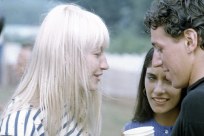 the program as from Albany, Georgia, and an original member of the Freedom Singers. She'd record an album for Folkways just after the festival, but it wouldn't be for some 8 years before she got the fame she deserved as founder of Sweet Honey In The Rock. This day, though, the Fariñas would be a hard act to follow. the program as from Albany, Georgia, and an original member of the Freedom Singers. She'd record an album for Folkways just after the festival, but it wouldn't be for some 8 years before she got the fame she deserved as founder of Sweet Honey In The Rock. This day, though, the Fariñas would be a hard act to follow. Closing Ceremonies
It was traditional on the last night to assemble as many of that weekend's performers on one stage and form a huge chorus -- in 1963, everyone had gotten together and sung "We Shall Overcome." For that night's finale, Pete Seeger lead the collected performers and the audience in a version of " Don't Study War No
 More." As the camera scans the packed main stage, it pans across the front row, past Bernice Reagon, Pete More." As the camera scans the packed main stage, it pans across the front row, past Bernice Reagon, Pete Seeger, Joan Baez, and pauses for a second and comes back, but in that second you can catch a glimpse of Mimi in a scarf and Dick looking around the stage and audience with smiling eyes. And just before the fade, Dick is caught alone in a grin that needs cinerama. Seeger, Joan Baez, and pauses for a second and comes back, but in that second you can catch a glimpse of Mimi in a scarf and Dick looking around the stage and audience with smiling eyes. And just before the fade, Dick is caught alone in a grin that needs cinerama. Lord Buckley said, "If you get to it and can not do it, there you jolly well are, aren't you?" Richard and Mimi Fariña had gotten there and done it with balloons on and would be whispered about and celebrated for their gray day until people stopped talking.
They'd return to touring small clubs after this and relocate from Cambridge to Carmel to help Joan in her Institute For The Study Of Non-violence until the end of September, when Vanguard would pay for their flight back to New York for a "Sing-In For Peace in Vietnam" at Carnegie Hall because it was also time to record their second album. Reflections In a Crystal Wind would be recorded in the last few days of September and be released at the end of the year.
In the spring of the next year, Sing Out! lists a roster of performers scheduled for that summer's 1966 Newport Folk Festival. The Fariñas are included.
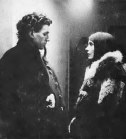 |
|
Baez, Joan. Daybreak. New York: Dial Press, 1968.
Baez, Joan. And a Voice To Sing With. New York, Summit Books, 1987.
Bikel, Theodore. Theo: The autogiography of Theodore Bikel. New York: HarperCollins Books, 1994.
Boyd, Joe. White bicycles : making music in the 1960s. London: Serpent's Tail, 2005.
Cantwell, Robert. When We Were Good: The Folk Revival. Cambridge, Massachussetts: Harvard University Press, 1996.
Cohen, Ronald D. Rainbow quest : the folk music revival & American society, 1940-1970. Boston, University of Massachusetts Press, 2002.
Collins, Judy. The Judy Collins Songbook. New York: Grosset & Dunlap, 1969.
Crenshaw, Marshall. Hollywood Rock : a Guide To Rock'n'Roll in the Movies. New York : HarperPerennial, 1994.
Fariña, Mimi. Letter to the author, June 26, 1995.
Fariña, Richard. The Songs of Richard Fariña. New York: Music Publishers Holding Corporation, 1967.
Gahr, David. The Face of Folk Music. New York: Citadel Press, 1968.
Goodman, Walter. The Committee : The Extraordinary career of the House Committee on Un-American Activities. New York: Farrar, Straus & Giroux, 1968.
Hajdu, David. Positively 4th Street : The Lives and Times of Joan Baez, Bob Dylan, Mimi Baez Fariña and Richard Fariña. Farrar, Straus & Giroux. New York, 2001.
Heylin, Clinton. Bob Dylan : Behind the Shades. New York: Summit Books, 1991.
Jackson, Bruce. "Newport." Sing Out! - v.16, number 4, Aug/Sept. 1966
Jones, Robert L. Interview with the author, Nov. 1994.
Kooper, Al. Backstage Passes. New York: Stein & Day, 1977.
Kramer, Daniel. Bob Dylan : A Portrait of the Artist's Early Years. New York: Citadel Underground, 1991.
Lefcowitz, Eric. Tomorrow Never Knows : The Beatles Last Concert. San Francisco: Terra Firma, 1987.
Malcolm, Janet. The Silent Woman : Sylvia Plath & Ted Hughes. New york. Knopf, 1994.
Murray, Charles Shaar. Boogie Man : The Adventures of John Lee Hooker in the American Twentieth Century. New York: St. Martin's Press, 2000.
Ritchie, Jean. Jean Ritchie's Dulcimer People. New York: Oak Publications, 1975.
Scaduto, Anthony. Bob Dylan : An Intimate Biography. New York: Grosset & Dunlap, 1971.
Shelton, Robert. No Direction Home : The Life and Music of Bob Dylan. New York: Beech Tree Books, 1986.
Sounes, Howard. Down the Highway : the Life of Bob Dylan. New York: Grove press, 2001.
Sptiz, Bob. Dylan : a Biography. New York: McGraw-Hill, 1989.
Unterberger, Richie. Interview with Bruce Langhorne avail at www.richieunterberger.com
Unterberger, Richie. Urban Spacemen and Wayfaring Strangers: Overlooked Innovators and Eccentric Visionaries of '60s Rock. San Francisco: Miller-Freeman Books, 2000.
Vassal, Jacques. Electric Children : Roots and Branches of Modern Folkrock. New York : Taplinger Publishing Company, 1976.
von Schmidt, Eric and Jim Rooney. Baby Let Me Follow You Down, The Illustrated Story of the Cambridge Folk Years (2nd ed.). Amherst, Massachusetts: University of Massachusetts Press, 1994.
Williams, Richard. Dylan : A Man Called Alias. New York: Henry Holt and Company, 1992.
Woliver, Robbie. Bringing It All Back Home. New York: Pantheon Books, 1986.
Woodward, Ian. Phone conversation with the author, Dec. 2001
Yarrow, Peter. Interview with the author, May, 1995.
|
Ó 2002, 2003 Greg Pennell
last updated 2 mar'10
|